Copyright © 2007 Lion Precision. www.lionprecision.com
Summary
This TechNote describes the process of field calibrating eddy-current drivers ECL101, ECA101, and ECL130. This procedure is limited to calibrations to the original factory range and specifications.
ECL101
The ECL101 output is 0-10VDC. Zero volts is at the closest point to the target, called the offset.
These instructions are for recalibration to the original range as shipped from the factory. Calibration to a significantly different range and/or offset will adversely affect the range LEDs operation, and the temperature and resolution specifications.
A suitably precise method to accurately adjust the probe/target gap is required for calibration.
- Position the Front Panel Zero adjustment to the mid-point (25 turns in one direction, and 12 turns back will center the adjustment).
- Set the probe/target gap to the minimum (offset).
- Use the Calibration Zero adjustment on the bottom of the device to set the output voltage to 0.00 VDC.
- Position the probe/target gap to the mid-point of the range.
- Use the Calibration Gain to set the output to 5.00VDC.
- Position the probe/target gap to maximum.
- Use the Calibration Coarse or Fine Linearity to set the output voltage to 10.00VDC.
- Repeat steps 2-7 until no further adjustments are needed (see hint below).
Hint: When adjusting linearity, adjust the output for the same but opposite amount of error voltage. For example, if the output is 9.950VDC adjust it to 10.050VDC. This will shorten the total number of iterations of steps 2-7. As the linearity adjustment approaches 10 volts, use Fine Linearity for finer control.
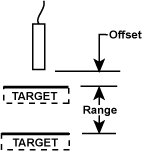
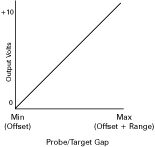
The ECL101 output is 0-10VDC. Zero volts is at the closest point to the target, called the offset.
ECL130
The ECL130 output is ±10VDC. Zero volts is at the center of the range, called the standoff, -10V is at the point closest to the target.
These instructions are for recalibration to the original range as shipped from the factory. Calibration to a significantly different range and/or offset will adversely affect the range LEDs operation, and the temperature and resolution specifications.
A suitably precise method to accurately adjust the probe/target gap is required for calibration.
- Set the gap to standoff (Range Center).
- Set the output to 0.000VDC with the Coarse and Fine Zero adjustments.
- Set the gap to Near (smallest gap).
- Set the output to –10.000VDC using the Gain adjustment.
- Set the gap to Far (largest gap).
- Set the output to +10.000VDC using the Coarse and Fine Linearity adjustments.
- Because the adjustments interact, repeat steps 1-6 as needed (see hint).
Hint: When adjusting linearity, adjust the output for the same but opposite amount of error voltage. For example, if the output is 9.950VDC adjust it to 10.050VDC. This will shorten the total number of iterations of steps 1-6. As the linearity adjustment approaches 10 volts, use Fine Linearity for finer control.
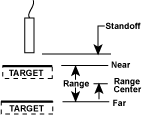
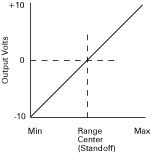
The ECL130 output is ±10VDC. Zero volts is at the center of the range, called the standoff, -10V is at the point closest to the target.
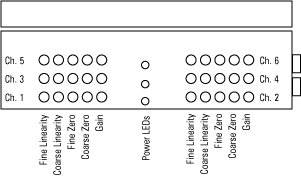
ECL130 Adjustment Locator
ECA101
The ECA101 output is 0-10VDC. Zero volts is at the closest point to the target, called the offset.
A suitably precise method to accurately adjust the probe/target gap is required for calibration.
- Set the probe/target gap at minimum (offset)
- Adjust Front Panel Zero for 0VDC output
- Set the probe/target gap to maximum
- Adjust Front Panel Gain for desired output voltage (typically 10VDC)
- If the output voltage will not adjust to the desired output voltage:
If the output is below the desired voltage, the range will have to be increased.
If the output is above the desired voltage, the range will have to be decreased. - Verify that the output voltage changes throughout the range.
There is an absolute maximum and minimum gap beyond which the output will not change. Verify that these points are not within your calibrated range.
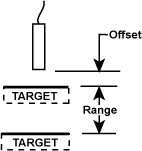
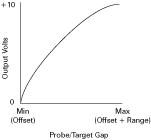
The ECA101 output is 0-10VDC. Zero volts is at the closest point to the target, called the offset.
